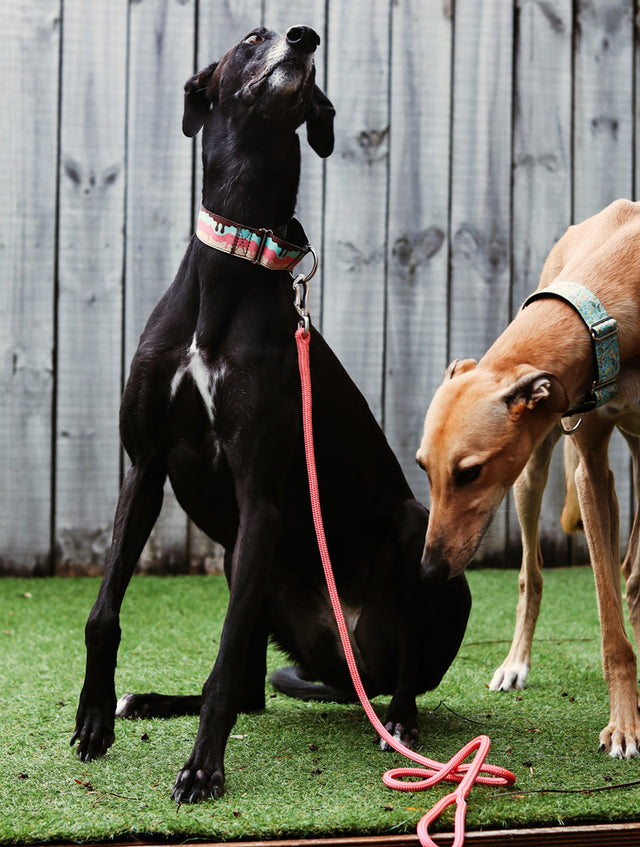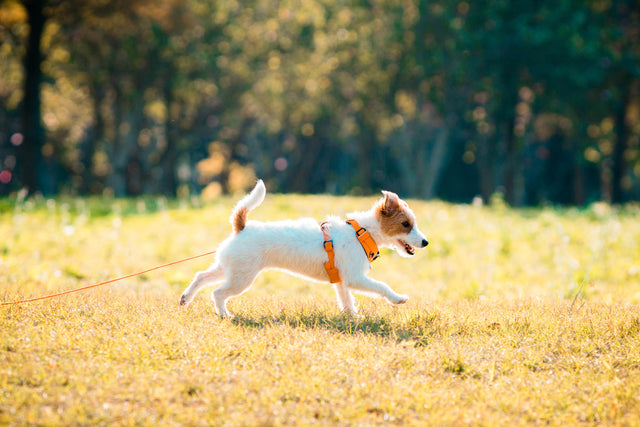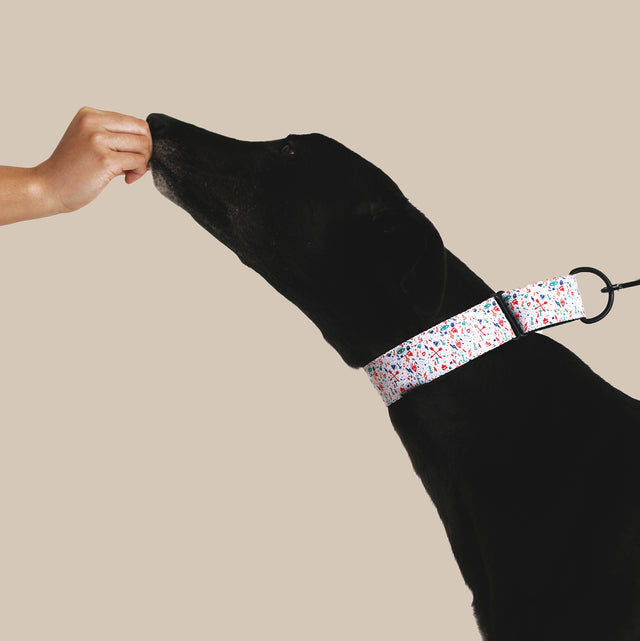Martingale Collar Guide
What is a Martingale Collar?
Martingale dog collars are also known as Greyhound collars, or Sighthound collars, because sighthounds' necks are larger than their heads and they can often slip out of traditional dog collars.

How does a martingale collar work?
A martingale collar is made with two loops. The large loop is placed around dog’s neck and adjusted to fit loosely around the base of the neck. The smaller loop where there is a D-ring to attach the leash to.

When your dog tries to pull, the tension on the leash pulls the small loop taut, which makes the large loop smaller on the neck.
Unlike traditional dog collars that have to be buckled tight to prevent escape, and press on the front of a dogs neck when they pull on the lead. A properly fitted martingale collar will sit loosely and comfortably around the base of the neck, but will naturally tighten up and distribute pressure safely around the dogs' neck when tension is applied; and revert back when the tension is lifted.
Why do professional dog trainers use martingales?
Martingales are recommended by trainers for improving leash walking. If you prefer a gentle control while working on leash manners or agility training, martingale collar is a nice option. Properly fitted, martingale collars are safely at preventing pulling, escaping or other unwanted behaviours.
Is Martingale collar only for Greyhounds?
No, martingale collars aren’t just limited to Greyhounds! It’s certainly not for all, especially when your pup is very small. However, they're a safe and comfortable option for a variety of dog breeds if it fits properly.

(photo credit: @kenzoshiba_nz)
They are much gentler than a buckle collar or a choke collar. Martingale collars offer more support and more control in certain situations. If a dog is prone to slipping out of a traditional dog collar, then a martingale collar may be recommended when leash walking. If a dog likes pulling when on lead, a martingale collar can be useful for improving leash walking and eliminating pulling.
Trying to decide if a martingale collar might be worth considering? Check out our blog post about 'Why do Dogs use Martingale Collars' for more information.
Can a dog wear a Martingale collar all the time?
Martingales are designed to be used on leash. We recommend to use your martingale collar as a functional dog jacket. You wear it when you go outside, and take it off when you get home.
How to wear?

Size Guide
1. Use a string or tape to form a loop.
2. Adjust it to find the loop that can easily slide over your pup’s head.
3. Once on, ensure that it can also slide off without hurting your pup’s ears. Then, measure the length of the loop.
4. Then measure the circumference of where you would like the collar to sit on your pup's neck when in use.
5. Now you have these two measurements (add an extra 3cm), compare them to our sizes below. If our size covers both of these measurements, then the collar is the right size for your dog!
Your martingale collar should sit the base of your dog's neck loosely and comfortably. It only tightens when it’s necessary and revert back when the tension is lifted.
Size M: 34cm to 50cm
Greyhounds, Whippets, Vizsla, Huntaway, Thai Ridgeback, Border Collie, Labradoodles, Giant Schnauzers, Dalmatian, etc.
Size L: 44cm to 64cm
Golden Retriever, Labrador Retriever, German Shepherd, Wolfhounds, Malamutes, Huskies, afghan hound, Border Collie, Boxer, Dalmatian, etc.
Dog breeds are given as a guide only. Please measure your dog’s neckbefore purchasing.
To give a sense of stability to dogs' neck, our collars are 38mm (1.5") wide which is wider than a regular collar.



